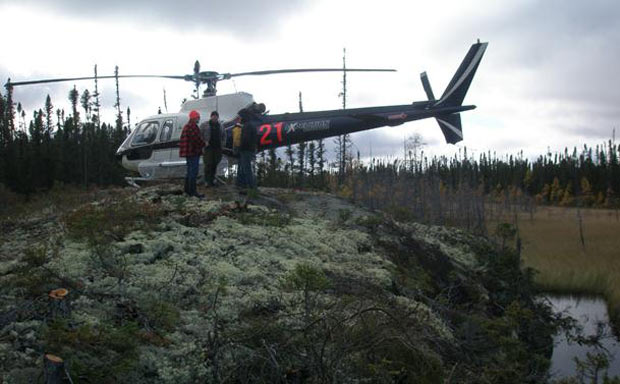

Ontario Mining Decisions Impact the Industry
SUDBURY – Commentary – On Sept. 10, Ontario’s Mining and Lands Commissioner set off a nuclear explosion in Ontario mining circles and announced that tiny Canadian-owned KWG Resources would not have to give American iron ore giant, Cliffs Natural Resources, access to its staked mining claims to construct a proposed road into the Ring of Fire.
In a proverbial David and Goliath bruising battle over a much sought-after route into Ontario’s newest mining camp, it was a precedent-setting sucker punch no one expected.
The Mining Commission report started with an understatement of the century: “The North is not a quiet place.” And with good reason.
Located 500 kilometres northeast of Thunder Bay, the Ring of Fire contains at least $60 billion and counting of chromite, plus nickel, copper, platinum group elements, gold, zinc and vanadium metals. The Cliffs’s chromite project has become a never-ending soap opera, similar in drama and intrigue to the failed Inco/Falconbridge merger in the middle of the last decade.
This is the latest setback that has a very bitter-sounding Cliffs issuing threatening news releases and interviews stating the entire project could be dropped if the Ontario government does not intervene and resolve this and other issues, including subsidized power rates and conflict over the terms of a provincial environmental assessment.
While many sympathize with Cliffs’ challenges, its recent public outbursts are starting to look like a corporate temper tantrum.
The company has since chosen to appeal the decision to the Divisional Court, but that will ensure a further delay of at least a year or so for its development proposals in the Ring of Fire. Given the company’s current financial condition and the depressed state of global metal markets, this is not entirely a bad situation.
In addition, Cliffs recently appointed Gary B. Halverson to the new position of president and chief operating officer, effective Nov. 18, to replace retiring CEO Joseph Carrabba. A former chief operating officer at Barrick Gold, much of Halverson’s extensive global experience in the past decade and a half or so has been connected with the gold sector. It’s an interesting metallurgical leap to iron ore, coal and chromite — Cliffs’ primary focus. However, many of these operations use open-pit mining methods and his expertise in complex tailings and water management issues will be critical in the waterlogged and flat geography of the Ring of Fire.
One of his first tasks will probably be a thorough overview of all projects and there is a small possibility that the company may walk away from this project despite its $535-million investment up to the end of 2013 ($350 million for the purchase of junior Freewest Resources, Spider Resources, a 16% interest in KWG Resources and $185 million from 2011 to 2013 on mine development). (Correction: An earlier version of this story had an incorrect number for the $535-million investment.)

Not to tempt the fates, but if Cliffs did walk away from the project, I suspect that there would be many potential buyers. And at current depressed prices, the project might be considered the mining bargain of the century. In addition, persistent rumours over the past year have indicated that Cliffs itself may become a possible takeover target.
Ring of Fire Cost Considerations
Costs prohibitive to developing Ring
The Ring of Fire area, which aspires to be Canada’s newest mining camp, is stranded in the swampy muskeg of the James Bay Lowlands, a terrain that makes road and rail construction expensive or near impossible. But due to some geological miracle, a north-south series of narrow, raised sandy ridges, the shore of a post-glacial lake, would economically allow the construction of a road or railway. KWG claim-staked this strategic route in 2009.
“Some people say this is proof that God is a mining engineer because he put a chromite deposit up there, and then he laid out a road for us,” says M. J. (Moe) Lavigne, vice-president of exploration and development at KWG Resources.
Without a doubt, one of the key issues is what type of transportation infrastructure should be built into the Ring of Fire and how — and who — should foot the bill.
Cliffs has proposed a road that would be partly subsidized by the Ontario government, while KWG plans a public-private partnership for a railroad that would be built by the Ontario Northland Railway through a newly formed Port Authority, with federal backing.
One of the key facts in the Ontario Mining Commission report was that,”there has not been any useful evidence that the tribunal could comfortably rely on to agree with Cliffs that two major transportation modes could co-exist in the prescribed location.”
Before I continue, a bit of background history is in order to understand the bitterness of this battle — a corporate bromance gone sour.
In 2006, Frank Smeenk’s KWG Resources, in partnership with another junior exploration company, Neil Novak’s Spider Resources, jointly discovered the first major chromite deposit known as the Big Daddy. Together, they controlled 60% of the deposit; the remainder was owned by Freewest Resources. Subsequently, other major chromite and nickel discoveries were made by juniors Freewest Resources (Black Thor) and Noront Resources (Eagle One) respectively.
As is often the case with juniors, KWG approached Cliffs Natural Resources, a major iron ore producer, with the hopes of forming some sort of a collaborative agreement. Cliffs found the deposit interesting and purchased a 19.9% —since diluted to 16% — stake of KWG for US$3.5 million and a seat on their board of directors.
It was Smeenk’s idea to secure the best north-south transportation route on a series of sand ridges through claim staking — by KWG’s subsidiary, Canada Chrome Corporation — with the full support from Cliffs. Both companies originally thought a railroad would be the preferred form of transportation and Cliffs suggested KWG make contact with Krech Ojard & Associates, an American engineering firm that its uses for the railroads at its iron ore operations. In total, KWG spent about $15 million on gathering geotechnical soils data and design engineering studies.
Then the corporate bromance started to unwind. Cliffs bought out Freewest Resources in 2010, which gave it 40% control over the Big Daddy deposit. In the late spring of the same year, Spider and KWG tried to merge, but Cliffs, through a hostile, lowball offer, tried to buy both. After a bidding war that kept increasing both juniors’ stock price, Cliffs finally took control of Spider, but called off the attempt for KWG when the price was going to be much higher than it was prepared to pay.
With only 30% control over the Big Daddy deposit, KWG was in a very vulnerable spot. Cliffs felt it was in control and decided that a road would be better than a railroad. However, the tiny chromite mouse did not roll over and play dead, since it still controlled the strategic route into the Ring of Fire.
Toronto’s junior exploration fraternity, the vast majority scattered among the tall office towers in the financial district, can be extremely competitive, but when it comes to granting access over claims for a road or power line, most will resolve the issue amicably without having to go to the Mining Commissioner. However, Cliffs request for surface access to KWG’s claims for their proposed road was almost tantamount to expropriation. And so the battle went to the Mining and Lands Commissioner of Ontario to settle.
The final report from the Mining Commissioner makes for an interesting read. It was “peeved” with the behaviour of the opponents.
“The tribunal was struck by the intransigence displayed by both sides in the matter when it came time to discuss their plans, not to mention the disingenuousness of Cliffs’ behavior, acting as though the claims had been staked for a purpose with which they did not agree or considered invalid,” stated the report.
The Mining Commissioner was also troubled by the fact “no provincial representative came forward to testify as to the provincial or public interest.”
This is not frivolous commentary. The provincial government needs to stop hiding behind its standard talking point that this is just a conflict between two private companies. The future economic development of the entire far northwest — an area practically the size of France — is being decided.
There needs to be considerable government participation to ensure the sustainable long-term economic interests of the region and its people are being looked after. Instead, this provincial disinterest makes it sound like the issue is akin to a zoning change in a strip mall in Mississauga. This attitude needs to change.
Ultimately, the Mining Commission “heard ample evidence to conclude that Canada Chrome Corporation would encounter serious issues that would negatively affect the development of its mining claims were Cliffs to obtain its desired easement.”
Regardless of the favourable ruling, many in the mining sector viewed or demonized KWG as the major problem blocking a multi-billion project. “I was a bit disappointed at the negative reaction of some of my industry colleagues,” KWG CEO Frank Smeenk says. “The Ring of Fire is a multi-generational development and Ontario needs to look at the project from a 50- to 100-year perspective, not only to serve the short term interests of one company.”
In a Sept. 20 news release, Cliffs Natural Resources said it “disagrees with the decision and contends that this is not an appropriate use of mining claims under the Ontario Mining Act. Further, the company sees no conflict between the legitimate uses of a mining claimholder and the proposed road, which has great benefits for Northern Ontario.”
Stan Sudol
Stan Sudol is a Toronto-based communications consultant and mining policy analyst who owns/edits www.republicofmining.com
Related articles













